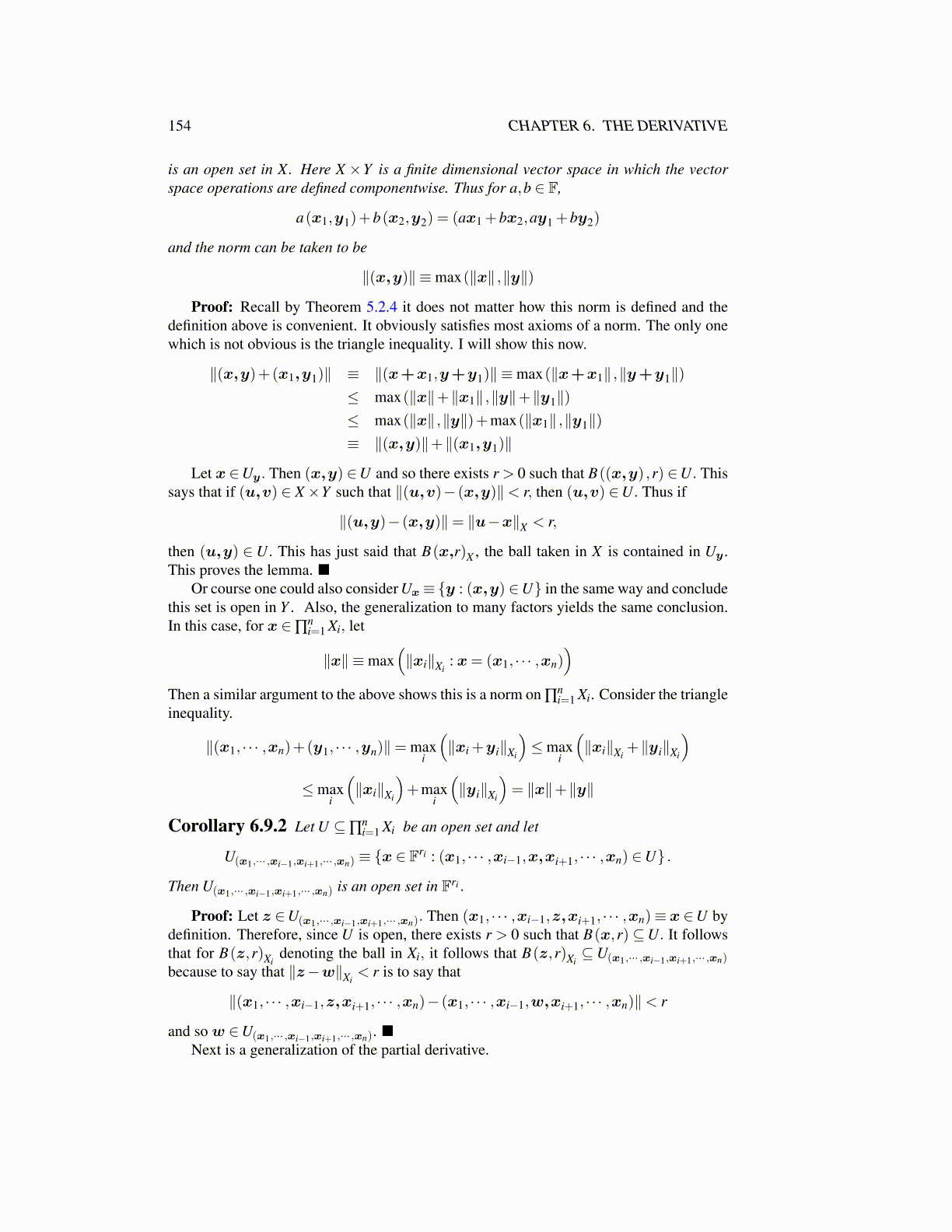
154 CHAPTER 6. THE DERIVATIVE
is an open set in X. Here X ×Y is a finite dimensional vector space in which the vectorspace operations are defined componentwise. Thus for a,b ∈ F,
a(x1,y1)+b(x2,y2) = (ax1 +bx2,ay1 +by2)
and the norm can be taken to be
∥(x,y)∥ ≡max(∥x∥ ,∥y∥)
Proof: Recall by Theorem 5.2.4 it does not matter how this norm is defined and thedefinition above is convenient. It obviously satisfies most axioms of a norm. The only onewhich is not obvious is the triangle inequality. I will show this now.
∥(x,y)+(x1,y1)∥ ≡ ∥(x+x1,y+y1)∥ ≡max(∥x+x1∥ ,∥y+y1∥)≤ max(∥x∥+∥x1∥ ,∥y∥+∥y1∥)≤ max(∥x∥ ,∥y∥)+max(∥x1∥ ,∥y1∥)≡ ∥(x,y)∥+∥(x1,y1)∥
Let x ∈Uy. Then (x,y) ∈U and so there exists r > 0 such that B((x,y) ,r) ∈U. Thissays that if (u,v) ∈ X×Y such that ∥(u,v)− (x,y)∥< r, then (u,v) ∈U. Thus if
∥(u,y)− (x,y)∥= ∥u−x∥X < r,
then (u,y) ∈U. This has just said that B(x,r)X , the ball taken in X is contained in Uy .This proves the lemma. ■
Or course one could also consider Ux≡{y : (x,y) ∈U} in the same way and concludethis set is open in Y . Also, the generalization to many factors yields the same conclusion.In this case, for x ∈∏
ni=1 Xi, let
∥x∥ ≡max(∥xi∥Xi
: x= (x1, · · · ,xn))
Then a similar argument to the above shows this is a norm on ∏ni=1 Xi. Consider the triangle
inequality.
∥(x1, · · · ,xn)+(y1, · · · ,yn)∥= maxi
(∥xi +yi∥Xi
)≤max
i
(∥xi∥Xi
+∥yi∥Xi
)≤max
i
(∥xi∥Xi
)+max
i
(∥yi∥Xi
)= ∥x∥+∥y∥
Corollary 6.9.2 Let U ⊆∏ni=1 Xi be an open set and let
U(x1,··· ,xi−1,xi+1,··· ,xn) ≡ {x ∈ Fri : (x1, · · · ,xi−1,x,xi+1, · · · ,xn) ∈U} .
Then U(x1,··· ,xi−1,xi+1,··· ,xn) is an open set in Fri .
Proof: Let z ∈U(x1,··· ,xi−1,xi+1,··· ,xn). Then (x1, · · · ,xi−1,z,xi+1, · · · ,xn)≡ x ∈U bydefinition. Therefore, since U is open, there exists r > 0 such that B(x,r)⊆U. It followsthat for B(z,r)Xi
denoting the ball in Xi, it follows that B(z,r)Xi⊆U(x1,··· ,xi−1,xi+1,··· ,xn)
because to say that ∥z−w∥Xi< r is to say that
∥(x1, · · · ,xi−1,z,xi+1, · · · ,xn)− (x1, · · · ,xi−1,w,xi+1, · · · ,xn)∥< r
and so w ∈U(x1,··· ,xi−1,xi+1,··· ,xn). ■Next is a generalization of the partial derivative.